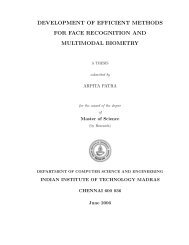The Enigma of Group Theory - Department of Computer Science ...
The Enigma of Group Theory - Department of Computer Science ...
The Enigma of Group Theory - Department of Computer Science ...
Create successful ePaper yourself
Turn your PDF publications into a flip-book with our unique Google optimized e-Paper software.
http://www.cs.bris.ac.uk University <strong>of</strong> Bristol, <strong>Department</strong> <strong>of</strong> <strong>Computer</strong> <strong>Science</strong><br />
This is a very cumbersome way to write a permutation. Mathematicians (being lazy people) have<br />
invented the following notation, the function f above is written as<br />
� �<br />
1 2 3<br />
.<br />
2 3 1<br />
What should be noted about this notation (which applies for arbitrary n) is that all the numbers between<br />
1 and n occur exactly once on each row. <strong>The</strong> first row is always given as the numbers 1 to n in increasing<br />
order. Any such matrix with these properties represents a permutation, and all permutations can be<br />
represented by such a matrix.<br />
<strong>The</strong> set <strong>of</strong> all permutations on a set <strong>of</strong> size n is denoted by Sn. <strong>The</strong> above matrix notation allows us<br />
to see very easily that the size <strong>of</strong> the set Sn is n!. To see this we notice that there are n choices for the first<br />
element in the second row <strong>of</strong> the above matrix. <strong>The</strong>n there are n − 1 choices for the second element in<br />
the second row and so on.<br />
Suppose we define the permutations<br />
g =<br />
� 1 2 3<br />
2 3 1<br />
�<br />
and f =<br />
� 1 2 3<br />
3 2 1<br />
As permutations are nothing but functions we can compose them. Remembering that g ◦ f means apply<br />
the function f and then apply the function g we see that<br />
� 1 2 3<br />
2 3 1<br />
�<br />
◦<br />
� 1 2 3<br />
3 2 1<br />
means 1 → 3 → 1, 2 → 2 → 3 and 3 → 1 → 2. Hence, the result <strong>of</strong> composing the above two<br />
permutations is<br />
�<br />
1<br />
1<br />
2<br />
3<br />
�<br />
3<br />
.<br />
2<br />
If σ is a permutation on a set A then we usually think <strong>of</strong> σ acting on the set. So if a ∈ A then we write<br />
a σ<br />
for the action <strong>of</strong> σ on the element a, i.e. this is another way <strong>of</strong> writing σ(a). However, this can cause<br />
confusion when using the standard notation for function composition above. For example<br />
1 g◦ f = g( f (1)) = 3<br />
so we are unable to read the permutation from left to right. However, if we use another notation say ·<br />
to mean<br />
f · g = g ◦ f<br />
then we are able to read the expression from left to right, i.e.<br />
1 f · g = g( f (1)).<br />
We shall call this operation multiplying permutations.<br />
Mathematicians are, as we said, by nature lazy people and this notation we have introduced is still a<br />
little too much. For instance we always write down the numbers 1, . . . , n in the top row <strong>of</strong> each matrix<br />
to represent a permutation. Also some columns are redundant, for instance the first column <strong>of</strong> the<br />
permutation<br />
� 1 2 3<br />
1 3 2<br />
We now introduce another notation for permutations which is concise and clear, which uses the concept<br />
<strong>of</strong> a cycle. By a cycle or n-cycle we mean the object (x1, . . . , xn) with distinct xi ∈ N \ {0}. This represents<br />
the permutation f (x1) = x2 , f (x2) = x3 , . . . , f (xn−1) = xn, f (xn) = x1 and for x � {x1, . . . , xn} we have<br />
f (x) = x. For instance we have<br />
� �<br />
1 2 3<br />
= (1, 2, 3) = (2, 3, 1) = (3, 1, 2).<br />
2 3 1<br />
5<br />
�<br />
.<br />
�<br />
�










